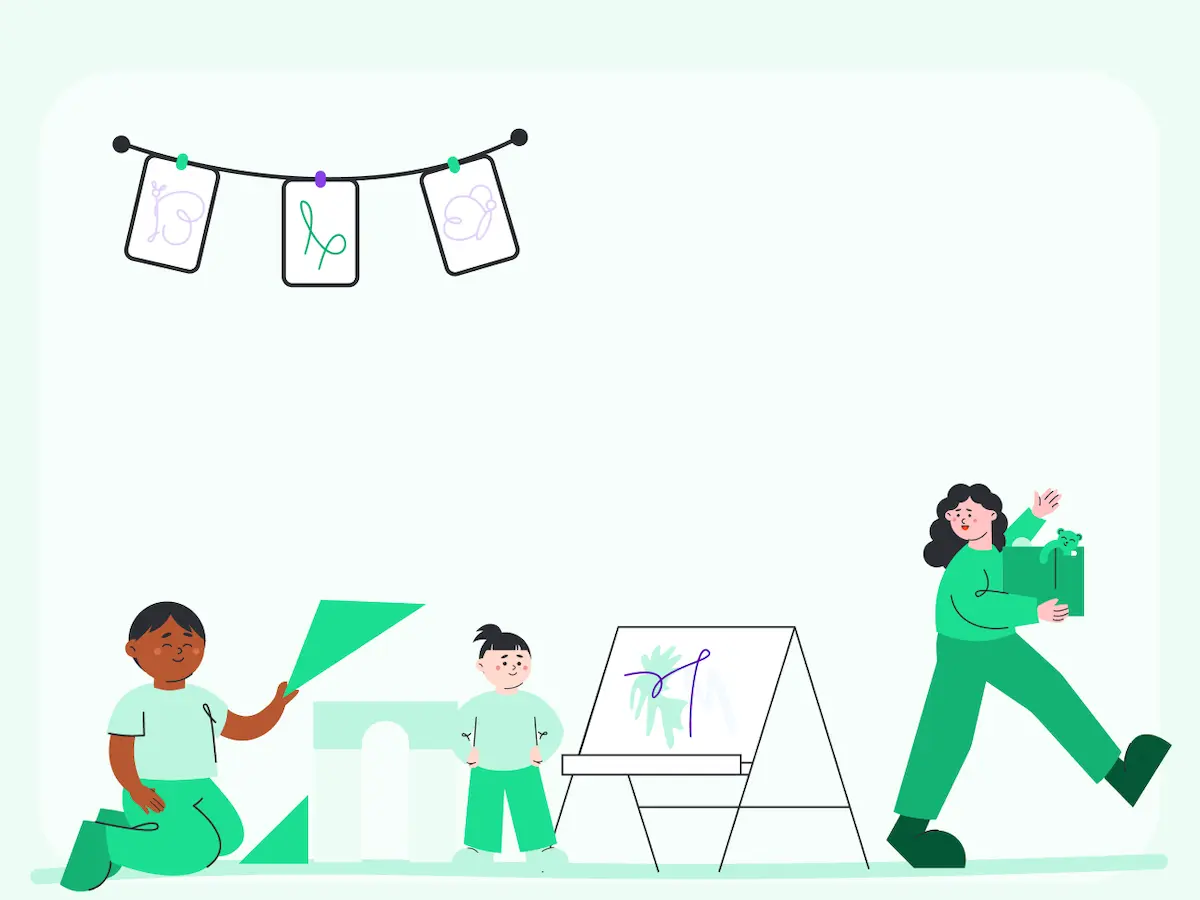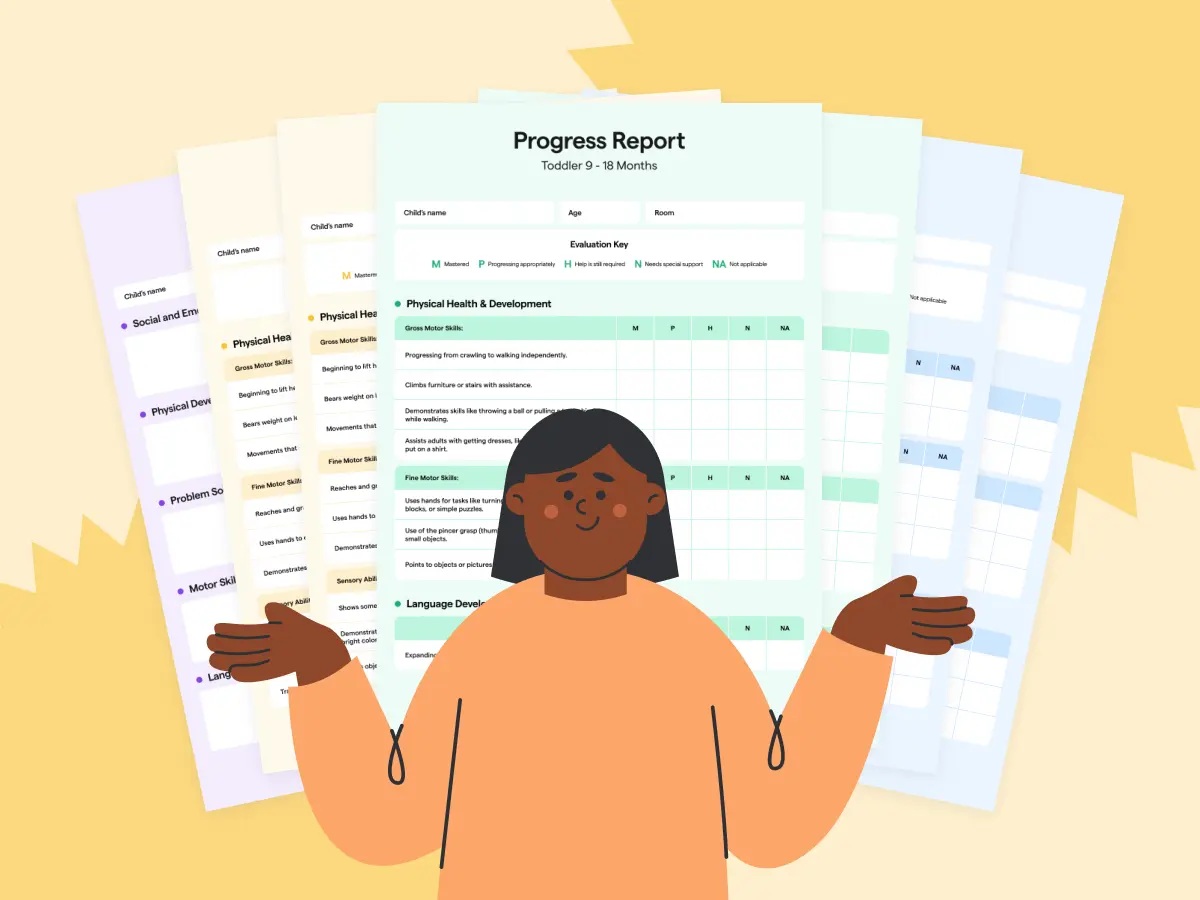settings
children
With Famly since
Is it just me, or do you feel like the U.S. is always planning way far in advance for the next holiday?
Now that the “back to school” commotion has passed, you have probably noticed Halloween decorations in the stores, and costume stores popping up all around, and you are beginning to think about how to decorate your classroom.
And this brings us to googly eyes…
Googly eyes are some of the best materials for Halloween themed learning activities for preschoolers. From pipe-cleaner spiders, to picture frames, to toilet paper monsters, and more - the googly eyed creations are endless.
But, what you may not have known is that googly eyes are actually great for a child's development - specifically their fine motor skills and hand-eye coordination. Googly eyes are not only a fun arts and crafts activity for preschoolers, but they are extremely beneficial to their overall development. So Halloween decorations aside, googly eyes are great materials for your lesson plans and activities.
We'll explain more below.
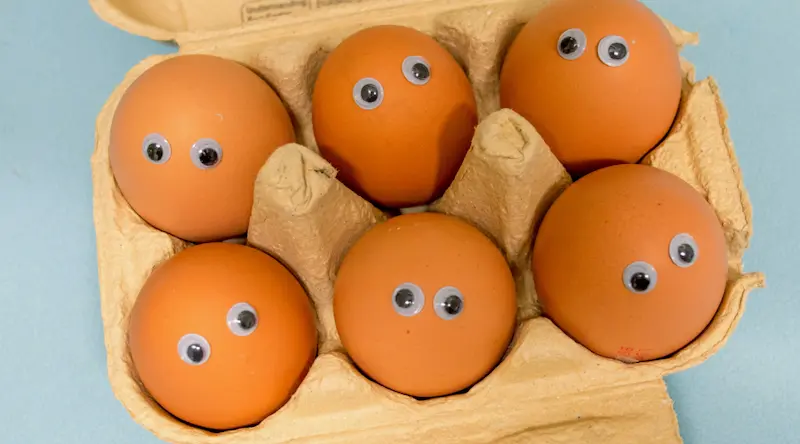
What are fine motor skills?
As defined by Children’s Hospital of Richmond at VCU, fine motor skills are movements that we do with our smaller muscles.
They are “generally thought of as the movement and use of hands and upper extremities,” and include actions like “reaching, grasping and manipulating objects with your hands.” Further, it is not just the movements themselves, but the ability to control those movements.
Visual-motor skills is also a type of fine motor skills, and is responsible for hand-eye coordination.
The children in your classroom are probably already working on these skills in your classroom with activities like jigsaw puzzles, stacking construction blocks, using crayons and paint brushes, etc.
The Children's Hospital of Richmond at VCU also explains that in addition to fine motor skills, we also have gross motor skills. Gross motor skills "involves the large muscles in the arms, legs and torso. Gross motor activities are important to everyday physical activities like walking, running, throwing, lifting, kicking, etc."
But, now back to fine motor movements and googly eyes.
The big ideas
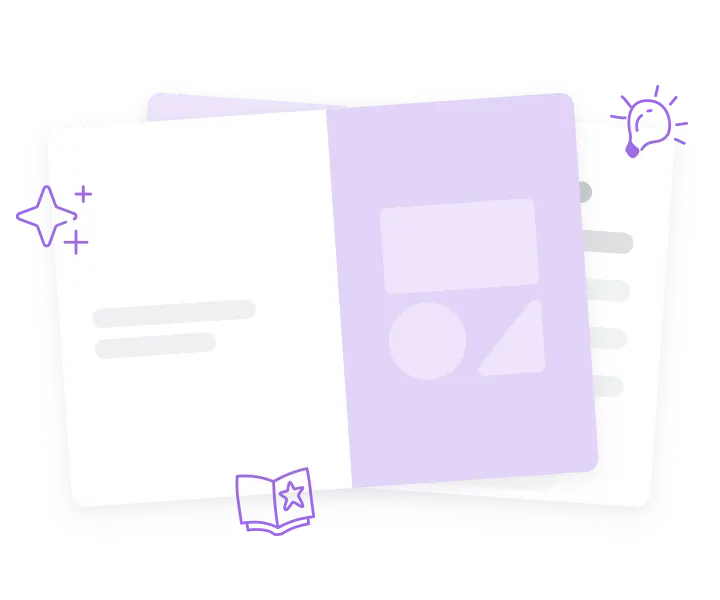
Why are fine motor skills so important in early childhood?
It is essential for little ones to engage in various activities that help them develop fine motor skills and motor control while their bodies and habits are still forming.
This article by Tanja Mcilroy broke down the reasons why developing fine motor skills in our younger years is so critical to our development and our future.
However, if you do not want to read that full post, it is actually very simple.
Fine motor skills enable children to gain independence and help with overall self-care and daily tasks, such as:
- Picking up their own food
- Brushing their teeth
- Putting on a seatbelt
- Getting dressed in the morning
- Turning pages of a book
- And so much more.
Additionally, their options of exploring creatively expands as they can interact with so many more objects and materials in their surroundings. This ability to engage and experiment more further enhances their learning skills and overall development, and provides an excellent foundation. As children develop their fine motor skills and gain more independence, they also gain more self-confidence.
Googly eyes are a great, creative place to start when trying to teach preschoolers fine motor skills.
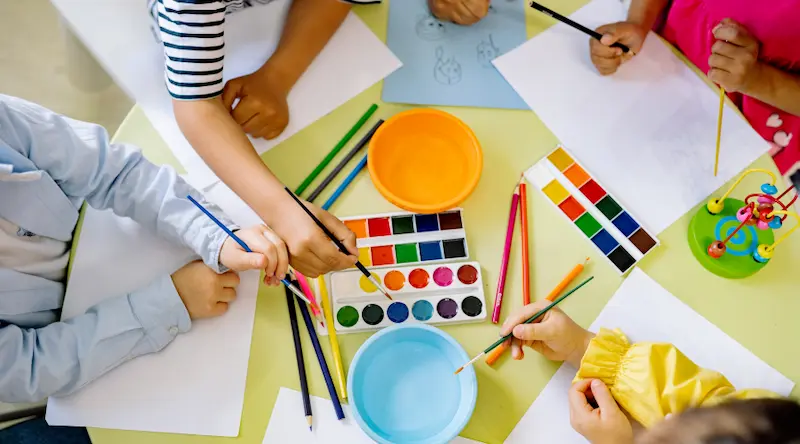
How can you improve the fine motor skills in preschoolers with googly eyes?
From picking up, to pinching, to sticking, to placing, the hand-eye coordination required when playing with googly eyes, it is fun craft activity for preschoolers, that also improves their fine motor skills development.
Here are some super simple examples of how googly eyes are great for development:
- Picking them up
Those tiny googly eyes provide a challenge for small fingers to grasp. You could even increase the challenge more by adding some tools like tweezers. Why not challenge the children to collect a certain number within a time limit? - Pinching them tightly
Once you’ve got hold of your googly eye, you’d better hold it tight! That special pincer grasp, where children hold a small object between their thumb and index finger is the foundation for the tripod grasp, needed to hold a pencil correctly. - Gluing googly eyes
From pipe cleaners to picture frames to paper towel rolls, the materials that googly eyes can be glued to are endless. Keeping hands steady and placing the googly eye where the child wants it is a great way to develop fine motor skills. Hand-eye coordination is key here, whether the children are using gloopy, runny glue or a solid stick. Encourage the children to experiment with both to see which combinations work best. - Placing them down
Once again, some good hand-eye coordination is needed here to get those googly eyes where you want them. Children could practice making a mark on their craftwork where they want to put the eyes, then carefully placing the eyes ‘on target’. Here’s a great opportunity to extend the activity by introducing some positional language, “Where should the eyes go? At the top, middle, or bottom? To the left or to the right?”
Googly eye activities for your preschool classroom
If you have ever ordered googly eyes, you know that they are sold in packs of at least 500. Let’s be honest. No one needs that many.
Once Halloween is over, you are still left with hundreds of googly eyes around the classroom. That’s why we gathered some fun activities for preschoolers that use googly eyes. These preschool activity ideas with googly eyes will be fun and support the child's fine motor skills and hand-eye coordination - at any time of the year
1. Bumble bee toilet paper rolls
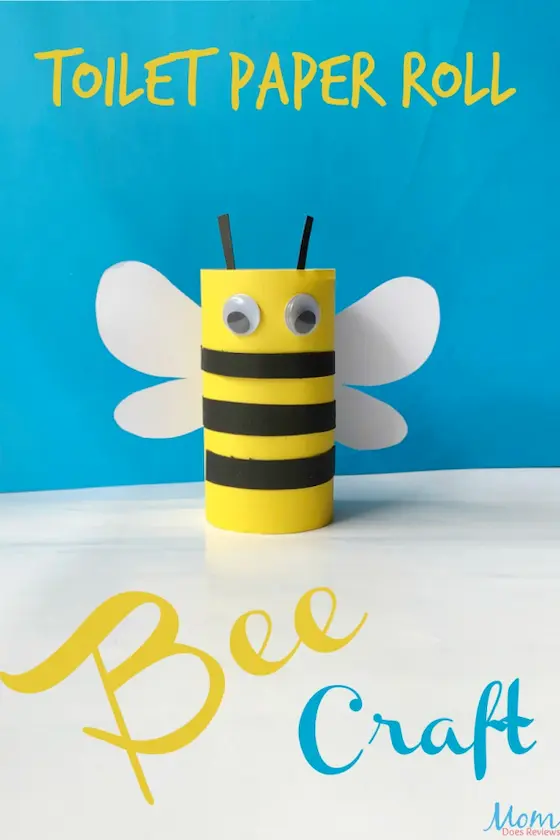
What you need:
- Tissue paper roll
- Yellow and black craft paper
- Glue
- Pencils
- Scissors
- A ruler
- Black marker pen
- Googly eyes
What to do
- Cut the yellow craft paper into a size that fits your tissue paper roll's height and circumference
- Then wrap the tissue paper roll with the yellow craft paper.
- Then, cut out 3-4 black stripes from the black craft paper and then glue them on the tissue paper roll horizontally (like bee stripes). Make sure to leave at least 1 inch gap on top part of the tissue paper roll.
- Use the black paper again to cut out the wings for the bee.
- Then glue the wings on the back of the toilet paper roll
- Next, cut out the antennas for the bee with the black craft paper and glue them on the top of the tissue paper roll.
- Finally glue the googly eyes on to the bee!
2. Pig Pom pom craft

What you need: (to make one pig)
- 2 pink craft pom poms, with 1 that is larger than the other
- Pink foam sheet
- Pink pipe cleaner
- Pink button
- Googly eyes
- Glue
What to do:
- First, cut the ears and feet out of the pink foam and then put them to the side.
- Then, glue the smaller pom pom on the top of the bigger pom pom
- Then, glue on the ears and feet that you already cut out.
- Now time to make a tail! Cut a piece of pipe cleaner and curl it into a spiral.
- Glue one side of the tail on the larger pink pom pom, so that the curly end sticks off to the side (so it looks like a tail)
- Last, glue on the googly eyes and a button for the nose/snout
3. Paper monster bookmarks
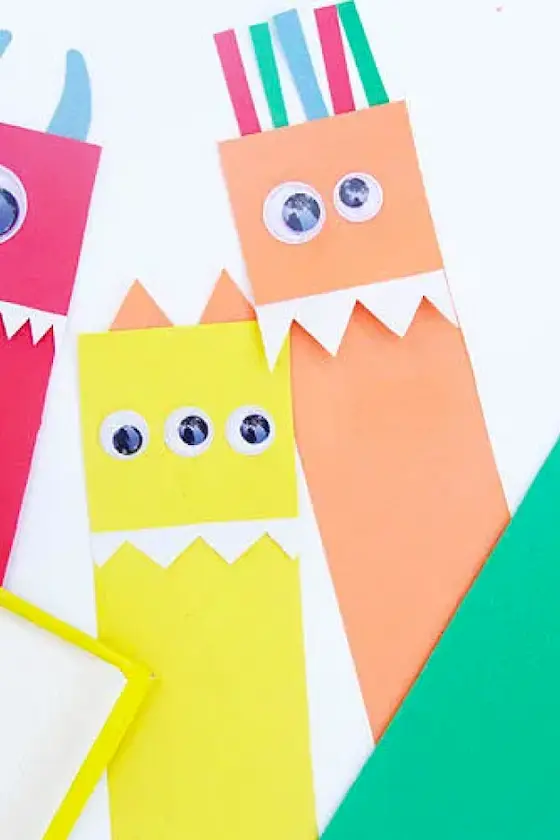
What you need
- Construction paper - any color, and as many colors as you want!
- White paper
- Ruler
- Googly eyes
- Glue stick
- Scissors
- Optional: Stickers, ribbon, rhinestones, glitter, buttons or markers for decoration
What to do:
- Cut one piece of colored construction paper into a 2x6 inch strip.
- With that same piece of construction paper, cut a square that is 2x2 inches.
- Cut a second, same size square from the white printer paper.
- Then, cut along the bottom of the white square in a zigzag pattern (this will be the monster's teeth).
- Glue the white square on top of the colored square so that the teeth are visible underneath the colored square.
- Flip the squares over.
- Glue the square with teeth to the top of the first strip of paper that you cut. Make sure to leave 3/4 of the square un-glued to form the mouth.
- Glue on the googly eyes.
- Then, glue another zigzag strip of white paper below the first one to create a second set of teeth.
- Decorate the bookmark any way you would like with all the optional materials - you can add hair, ears, sparkles, etc.

4. Farm animal craft sticks
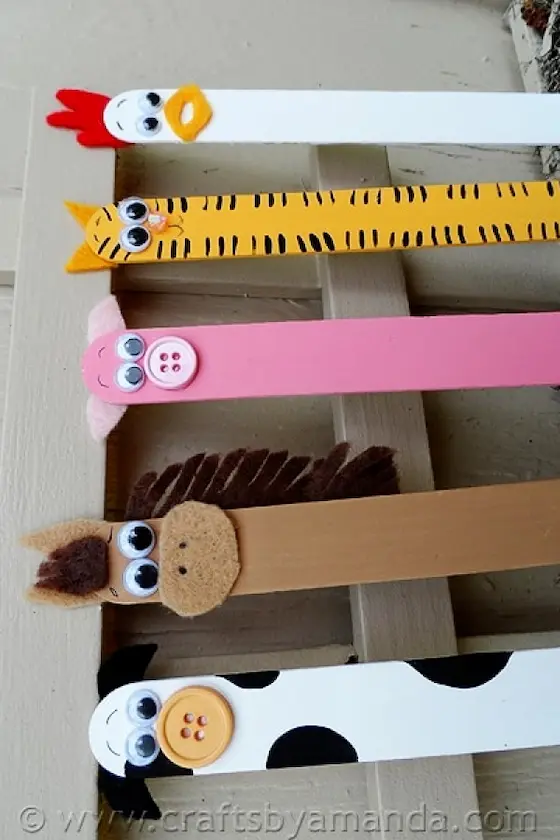
What You’ll Need
- 5 jumbo craft sticks
- Googly eyes
- Tan and pink Buttons
- Small pink bead
- Scissors
- Glue or glue dots
- Felt: light brown, dark brown, black, pink, orange, and red
- Paint: white, black, light brown, pink and orange
- Fine point marker
What to do:
- Begin by painting the craft sticks. Two of them will be white and the other three will be pink, light brown, and orange. paint some black splotches randomly on one of the white sticks.
- Use a thin paint brush (or you can use a black Sharpie!) to add stripes to the orange stick.
- Pig’s ears – pink
- Cow’s ears – black
- Horse’s ears and snout – light brown
- Horse’s mane and forelock – dark brown
- Chicken’s comb: red
- Chicken’s beak: orange
- Cat’s ears: orange
- You can use glue, or if you like Glue Dots, to attach the googly eyes to each craft stick. Glue the felt pieces in place for each animal and glue on buttons and the cat’s nose bead, and you have yourself a barn full of new friends!
5. Pipe cleaner monkeys
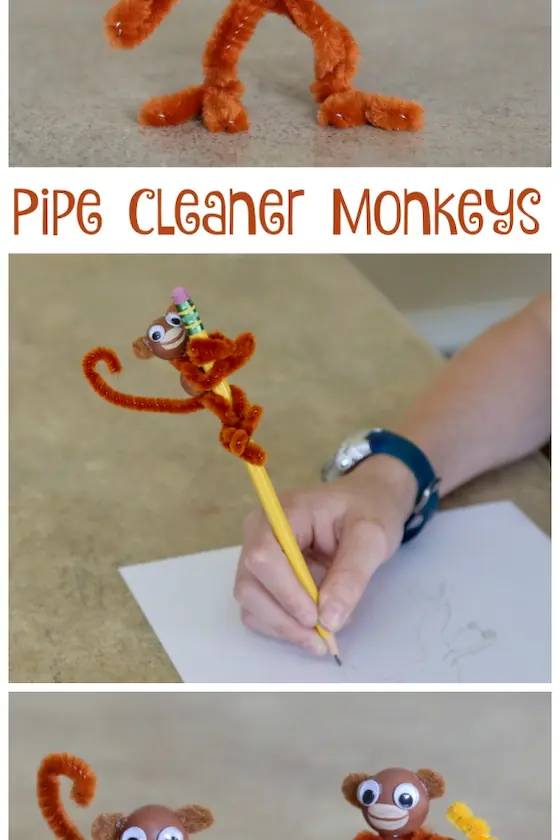
- Wooden beads
- Brown pipe cleaners – 3 per monkey
- Googly eyes
- Hot glue
- Brown felt
- Brown and tan acrylic paint
- Optional: Yellow pipe cleaners – for bananas
What to do:
- Start with your 3 brown pipe cleaners, and twist them together (photos in the link above are helpful!). The top three strands will be for the head and arms. The bottom three will make the legs and tail.
- Then, slide the body bead onto all three lower strands.
- Once the bead is on, start bending the pipe cleaner legs to make feet.
- Then, bend the arms.
- Cut the head part so that you have just enough left to fold over to be a neck.
- Then attach the head with a little hot glue.
- Finally, Then cut tiny rounded ears out of felt and glue those to the sides of the head.
- And the final touch is optional, but you can use the yellow pipe cleaner to make a banana, and place it so it looks like the monkey is holding it.
These are really fun to wrap around different objects, like the top of your pencil as shown in the picture above!
Please note: here at Famly we love sharing creative activities for you to try with the children at your setting, but you know them best. Take the time to consider adaptions you might need to make so these activities are accessible and developmentally appropriate for the children you work with. Just as you ordinarily would, conduct risk assessments for your children and your setting before undertaking new activities, and ensure you and your staff are following your own health and safety guidelines.
Free downloadable Early Childhood resources
Explore our library of longer-form books, guides and editable templates - all free to download.
Explore free resources




